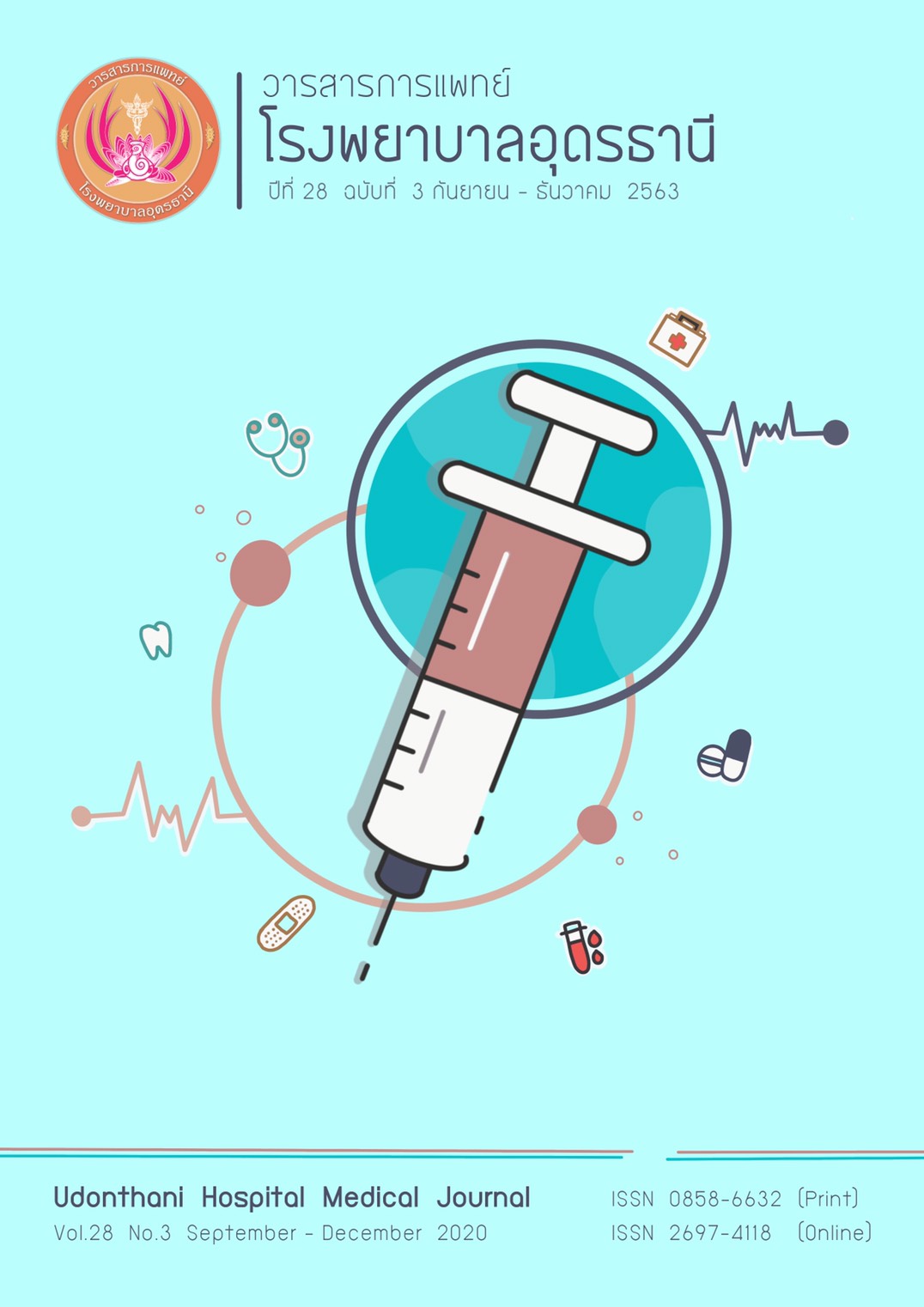ประสิทธิภาพของการตรวจคัดกรองมะเร็งปากมดลูกที่ผลผิดปกติด้วยวิธีแป๊ปสามัญในโรงพยาบาลมหาสารคาม
บทคัดย่อ
มะเร็งปากมดลูกเป็นมะเร็งที่พบบ่อยในหญิงไทยและทั่วโลก โรงพยาบาลมหาสารคามได้เข้าร่วมโครงการตรวจคัดกรองมะเร็งปากมดลูกระดับชาติตั้งแต่ปี 2548 จนถึงปัจจุบัน ปัจจุบันยังไม่มีการศึกษาประสิทธิภาพของการตรวจคัดกรองมะเร็งปากมดลูกที่ผลผิดปกติในโรงพยาบาลมหาสารคาม จึงเป็นที่มาของการศึกษานี้ที่มีวัตถุประสงค์เพื่อศึกษาประสิทธิภาพของการตรวจคัดกรองมะเร็งปากมดลูกที่ผลผิดปกติด้วยวิธีแป๊ปสามัญในโรงพยาบาลมหาสารคาม เป็นการศึกษาแบบ diagnostic test study โดยเก็บรวบรวมข้อมูลย้อนหลังจากผลการตรวจแป๊ปสามัญ (conventional pap smear) ตั้งแต่ พ.ศ.2558 ถึง 2562 จำนวน 139,268 ราย และผลที่ผิดปกตินำไปวิเคราะห์ร่วมกับผลพยาธิวิทยาของการตัดชิ้นเนื้อจากการส่องกล้องคอลโปสโคป
ผลการศึกษา จากการตรวจคัดกรองมะเร็งปากมดลูกด้วยวิธีแป๊ปสามัญจำนวน 139,268 ราย พบว่ามีกลุ่มที่ผลผิดปกติจำนวน 530 ราย ความไวและความจำเพาะของการตรวจคัดกรองมะเร็งปากมดลูกที่ผลผิดปกติด้วยวิธีแป๊ปสามัญพบว่าในกลุ่ม low grade squamous intraepithelial lesion (LSIL) มีความไวร้อยละ 70 ความจำเพาะร้อยละ 64.57 ในกลุ่ม high grade squamous intraepithelial lesion (HSIL) พบความไวร้อยละ 73.25 ความจำเพาะร้อยละ 87.23 และในกลุ่มมะเร็งปากมดลูกมีความไวร้อยละ 54.17 และความจำเพาะร้อยละ 99.21
สรุป: พบว่าความไวและความจำเพาะปานกลางในกลุ่ม LSIL โดยมีความไวปานกลางแต่ความจำเพาะสูงในกลุ่ม HSIL และกลุ่มมะเร็งปากมดลูก ดังนั้นการพัฒนาคุณภาพการเก็บเซลล์ตัวอย่าง การอบรมเพื่อเพิ่มทักษะการแปลผล และมีแนวทางการปรึกษาผู้เชี่ยวชาญเพื่อช่วยอ่านผลแป๊ปสามัญที่ไม่ชัดเจนจะช่วยเพิ่มความไวและความจำเพาะของการตรวจคัดกรองมะเร็งปากมดลูกด้วยวิธีแป๊ปสามัญได้
เอกสารอ้างอิง
2. National cancer institute department of medical services ministry of public health Thailand. Hospital-based cancer registry annual report 2018 :4.
3. Behtash N, Mehrdad N. Cervical cancer: screening and prevention. Asian Pac J Cancer Prev 2006; 7:683-6.
4. Tanabodee J, Thepsuwan K, Karalak A, Laoaree O, Krachang A, Manmatt K, et al. Comparison of efficacy in abnormal cervical cell detection between liquid-based cytology and conventional cytology. Asian Pac J Cancer Prev 2015;16:7381-4.
5. Solomon D, Davey D, Kurman R, Moriarty A, O’Connor D, Prey M, et al. The 2001 Bethesda System: Terminology for reporting results of cervical cytology. JAMA 2002;287:2114-9.
6. Verma A, Verma S, Vashit S, Attri S, Singhal A.A study on cervical cancer screening in symptomatic women using Pap smear in tertiary care hospital in rural area of Himachal Pradesh, India. Middle East. Fertility Society J 2017;22:39-42.
7. Kanjanavirojkul N, Muanglek R, Yanagihara L.Accuracy of abnormal Pap smear at Thammasat university hospital. J Med Assoc Thai 2012;95(Suppl.1):S79-82.
8. Arbyn M, Sankaranarayanan R, Muwonge R, Keita N, Dolo A, Gombe C, et al. Pooled analysis of the accuracy of five cervical cancer screening tests assessed in eleven studies in Africa and India. Int J Cancer 2008;123:153-60.
9. Phaliwong P, Pariyawateekul P, Khuakoonratt N, Sirichai W, Bhamarapravatana K, Suwannarurk K. Cervical cancer detection between conventional and liquid based cervical cytology: 6-year experience in Northern Bangkok Thailand.Asian Pac J Cancer Prev 2018; 19(5): 1331-6.
10. Hadzi B, Hadzi M, Curcin N. Histologic classification and terminology of precancerous lesions of the cervix. Med Pregl 1999; 52: 151-5.
11. Teresa Ramirez Argamosa, Mark Angelo C. Ang, Agustina D. Abelardo, Michele H. Diwa, Christopher Alec A. Maquiling. Correlation of abnormal Pap smears with histopathologic results: Philippine general hospital experience (2014-2017). ACTA Medica Philippina 2019; 53(1): 52-8.
12. Nawaz FH, Begum A, Pervez S, Rizvi J. Prevalence of abnormal Papanicolaou smears and cytohistological correlation: A study from Aga Khan University Hospital, Pakistan. Asia Pacific Journal of Clinical Oncology 2005; 1(4): 128-32.
13. Chaithanya K, Kanabur DR, Parshwanth HA. Cytohistopathologic Study of Cerivcal Lesions. Int J Sci Stud 2016; 4(2); 137-40.
14. Vaishali J, Vyas A. Cervical Noeplasia-Cyto-Histological Correlation (Bethes-da System): A Study of 276 Cases. Journal of Cytology and Histology 2010; 1: 106.
15. Kalyani R, Sharief N, Shariff S. A Study of Pap Smear in a Tertiary Hospital in South India. J Cancer Biol Res 2016;4(3):1084.
16.Tamrakar S, Chawla C. A Clinical Audit of Pap Smear Test for Screening of Cervical Cancer. Nepal Journal of Obstetrics and Gynecology 2012; 7(2): 21-4.
17. Nanda K, McCrory DC, Myers ER, Bastian LA, Hasselblad V, Hickey JD, et al. Accuracy of the Papanicolaou test in screening for and follow-up of cervical cytologic abnormalities: a systematic review. Ann Intern Med 2000;132:810-9.
18. Koliopoulos G, Nyaga VN, Santesso N, Bryant A, Martin-Hirsch PPL, Mustafa RA, et al. Cytology versus HPV testing for cervical cancer screening in the general population.Cochrane Database of Systematic Reviews 2017;8(8)CD008587.DOI:10.1002/14651858.CD008587.pub2
19. Rojaluckanawong V.Sensitivity and specificity of colposcopic diagnosis in HSIL or worse. MJSSBH 2012;3:278-86.
20. Shanmugham D, Vijay A, Rangaswamy T. Colposcopic evaluation of patient with persistant inflammatory pap smear. Sch J App Med Sci 2014;2:1010–3.
21. Duggan MA. Cytologic and histologic diagnosis and significance of controversial squamous lesion of uterine cervix. Mod Pathol 2000;13:252-60.
22. สุรางค์ ตรีรัตนชาติ. การตรวจคัดกรองมะเร็งปากมดลูกวิธีใหม่. Chula Med J 2004;48:69-71.
23. Herbert A. Achievable standards. Benchmarks for reporting and criteria for evaluation cervical cytopathology. Sheffield: NHSCSP; 1995.
24. Sharma J, Toi PC, Siddaraju N, Sundareshan M, Habeebullah, S. A comparative analysis of conventional and Sure Path liquid-based cervicovaginal cytology: a study of 140 cases. J Cytol 2016;33(2):80-84.
ดาวน์โหลด
เผยแพร่แล้ว
รูปแบบการอ้างอิง
ฉบับ
ประเภทบทความ
สัญญาอนุญาต
การละเมิดลิขสิทธิ์ถือเป็นความรับผิดชอบของผู้ส่งบทความโดยตรง
ผลงานที่ได้รับการตีพิมพ์ถือเป็นลิขสิทธิ์ของผู้นิพนธ์ ขอสงวนสิทธิ์มิให้นำเนื้อหา ทัศนะ หรือข้อคิดเห็นใด ๆ ของบทความในวารสารไปเผยแพร่ทางการค้าก่อนได้รับอนุญาตจากกองบรรณาธิการ อย่างเป็นลายลักษณ์อักษร



